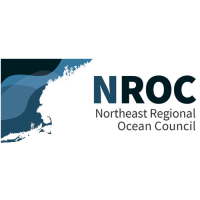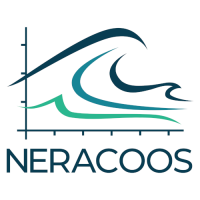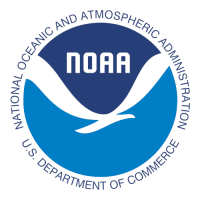About
About the Integrated Sentinel Monitoring Network
The Integrated Sentinel Monitoring Network (ISMN) coordinates data access and facilitates synthesis across observing program. It summarizes and interprets key ecosystem indicators, leading to increased awareness of ecosystem change in ocean and coastal ecosystems in the Northeast U.S.
Table of Contents (Jump to):
The scoop on Sentinel Indicators
It’s important to document the ways in which our oceans are changing, but we can’t document every single thing that’s happening; instead, researchers focus on key factors–like an animal or plant species, ecosystem feature, a type of chemical, or something else– that are sensitive to changes in their surroundings or play an especially important role in sustaining the ecosystem as we know it. We call these key factors “sentinel indicators” because when they start to act up, it’s a signal that everything connected to that indicator is changing, too.
Why we need to monitor
“The longer you can look back, the farther you can look forward.” -Winston Churchill
Watching and recording changes over time are important in all types of science, whether conducting an experiment in a laboratory or observing the natural world. Long-term monitoring is especially meaningful because fluctuations away from the ‘norm’ or usual state become more obvious. Understanding where we’ve come from and how we’re changing allows us to make better choices for how we move forward and adapt to those changes.
The power of an integrated monitoring system
It’s impossible for any one group (or even several groups!) to monitor the thousands of miles of coastline and the coastal ocean of the U.S. Northeast shelf. That’s why detecting changes in all these ecosystems requires a “network of networks” to tackle the jo. The vision of the Integrated Sentinel Monitoring Network is to work together to coordinate monitoring and share information, so that we can all have a more complete understanding of what’s happening and make smarter choices in our response.
How all of this impacts YOU
“Monitoring should detect change, and help people prepare.” -Casco Bay Estuary Partnership Monitoring Program
The ocean is a common good. Even if you live in the middle of the country and never go near the ocean, it benefits you indirectly–in the seafood you eat, or the oxygen (most of which is produced in the ocean) you breath. The people who are charged with managing ocean resources–your resources– need good information on which to base their decisions.
For example, resource managers might know that this year, 100 million pounds of fish were caught from the sea–but in the future, will there always be that amount of fish to catch? When they have access to long-term monitoring data, resource managers suddenly have context; they can see that a decade ago, the ocean was cooler and the water bringing food to very young fish was different, so maybe the capacity of the ocean to produce fish has changed. Without those monitoring data, resource managers are making decisions blindly and they might not pick the best course of action that balances what people need to live and what the marine environment needs to stay healthy.
History of the ISMN
The Northeastern Regional Association of Coastal Ocean Observing Systems (NERACOOS) and the Northeast Regional Ocean Council (NROC) come together to form the Joint Ocean and Coastal Ecosystem Health Committee, the precursor to the ISMN Oversight Committee
The 16-member ISMN Steering Committee convenes a series of open regional workshops to determine a collaborative approach to detecting ecosystem change
The ISMN Science & Implementation Plan, a comprehensive document outlining the ISMN's goals and activities, is created and distributed
The ISMN's proposal is selected to receive funding support from the National Oceanographic Partnership Program (NOPP) for inclusion in the Marine Biological Observing Network (MBON) effort
The ISMN Oversight Committee
The primary role of the Oversight Committee is to advise the ISMN Director on the implementation, integration and sustainability of ISMN activities.
The Oversight Committee will also:
- Identify priorities and opportunities for enhancement of present observing activities, guided by the community consensus provided in the S&I Plan.
- Establish and recruit participants in technical science committees to integrate and facilitate effectiveness of data collection, management, and analysis across ISMN activities.
- Guide the ISMN Director in acquiring funding and awarding grants for data synthesis and interpretation through the Center for Analysis, Prediction and Evaluation (CAPE).
Members of the Steering Committee
- Jeffrey Runge: University of Maine (Director)
- Jackie Motyka: NERACOOS (Co-director)
- Mel Coté: Environmental Protection Agency (EPA)
- Andy Pershing: Climate Central
- Carolina Bastidas: MIT Sea Grant
- Ben Haskell: NOAA Stellwagen Bank National Marine Sanctuary
- Catherine Johnson: Canada Department of Fisheries & Oceans; Bedford Institution of Oceanography
- Matt Lyman: Connecticut Department of Energy & Environmental Protection
- Carla Guenther: Maine Center for Coastal Fisheries
- Amy Trice: The Ocean Conservancy
- David Walsh: Woods Hole Group
- Hannah Webber: Schoodic Institute
- Matt Nixon: University of Maine
- David Nelson: NOAA National Center for Coastal and Ocean Studies
- Emily Shumchenia: Northeast Ocean Data Portal
- Harvey Walsh: NOAA Northeast Fisheries Science Center
- Heidi Sosik: Woods Hole Oceanographic Institution; LTER Network
- Kimberly Hyde: NOAA Northeast Fisheries Science Center
- Matt Liebman: EPA
- Regina Lyons: EPA
- Steve Couture: New Hampshire Department of Environmental Services




